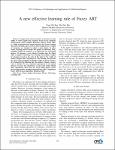



Unsupervised neural networks are known for their ability to cluster inputs into categories based on the similarity among inputs. Fuzzy Adaptive Resonance Theory (Fuzzy ART) is a kind of unsupervised neural networks that learns training data until satisfying a given need. In the learning process, weights of categories are changed to adapt to noisy inputs. In other words, learning process decides the quality of clustering. Thus, updating weights of categories is an important step of learning process. We propose a new effective learning rule for Fuzzy ART to improve clustering. Our learning rule modifies weights of categories based on the ratio of the input to the weight of chosen category and a learning rate. The learning rate presents the speed of increasing/decreasing the weight of chosen category. It is changed by the following rule: the number of inputs is larger, value is smaller. We have conducted experiments on ten typical data sets to prove the effectiveness of our novel model. Result from experiments shows that our novel model clusters better than existing models, including Original Fuzzy ART, Complement Fuzzy ART, K-mean algorithm, Euclidean ART.
Bản đồ thống kê
Thống kê nội dung

Unsupervised neural networks are known for their ability to cluster inputs into categories based on the similarity among inputs. Fuzzy Adaptive Resonance Theory (Fuzzy ART) is a kind of unsupervised neural networks that learns training data until satisfying a given need. In the learning process, weights of categories are changed to adapt to noisy inputs. In other words, learning process decides the quality of clustering. Thus, updating weights of categories is an important step of learning process. We propose a new effective learning rule for Fuzzy ART to improve clustering. Our learning rule modifies weights of categories based on the ratio of the input to the weight of chosen category and a learning rate. The learning rate presents the speed of increasing/decreasing the weight of chosen category. It is changed by the following rule: the number of inputs is larger, value is smaller. We have conducted experiments on ten typical data sets to prove the effectiveness of our novel model. Result from experiments shows that our novel model clusters better than existing models, including Original Fuzzy ART, Complement Fuzzy ART, K-mean algorithm, Euclidean ART.